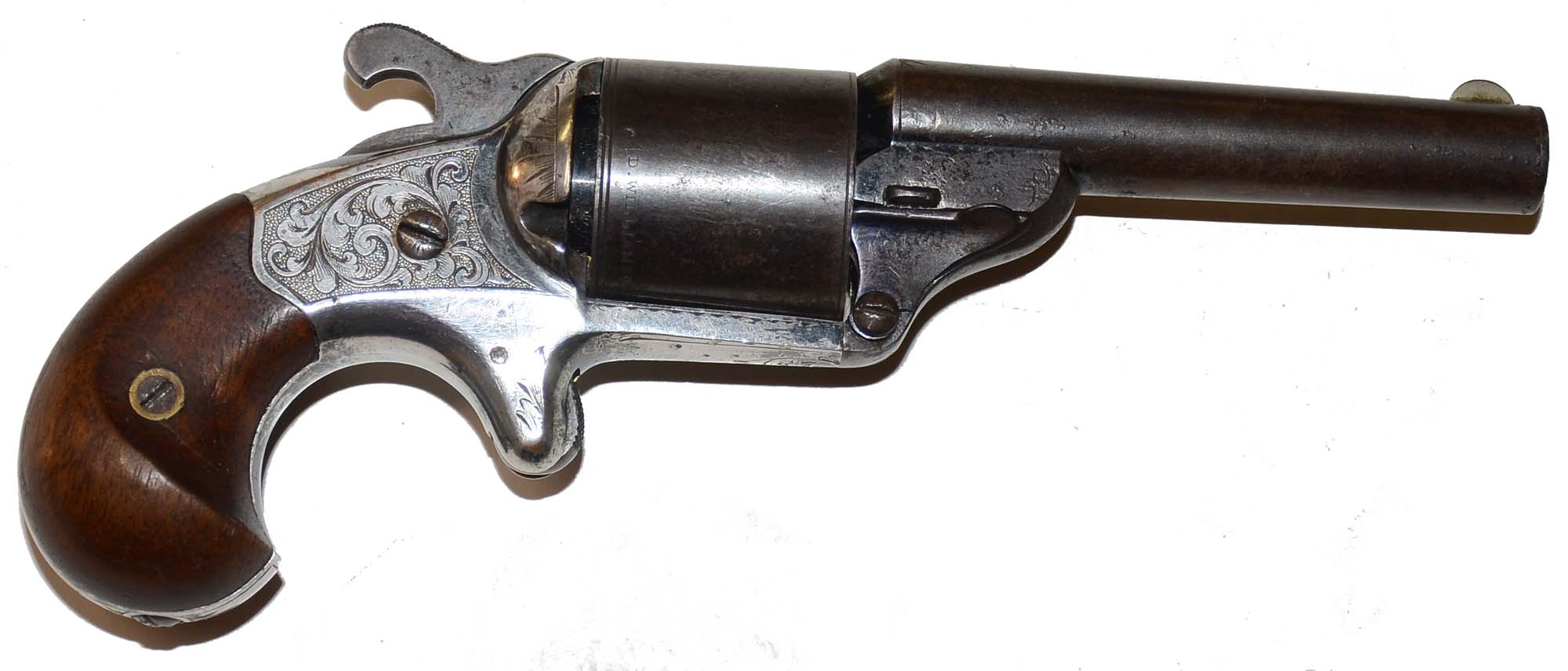site search
online catalog
MOORE FRONT LOADING REVOLVER WITH LOTS OF SILVER

Hover to zoom












$595.00 SOLD
Quantity Available: None
Item Code: 30-2172
Daniel Moore was hard man to keep down. When Smith and Wesson successfully sued him for infringing with his earlier revolver on the Rollin White patent for a cylinder bored all the way through, Moore designed a self-contained cartridge, nick-named the teat-fire cartridge, that would be loaded from the front of a cylinder that was not bored uniformly all the way through, but had just a small hole at the rear for the hammer to strike a small protrusion at the end of the cartridge holding the priming compound. These .32 caliber revolvers were popular and about 30,000 were produced from 1864 to 1870. This one is serial number 1419, placing it very early in the production run.
This pistol has very nice birdshead grips with a tight fit to the frame and no dings or scratches. The barrel and cylinder preserve about 90 percent of their finish, though it has shifted from largely from blue to plum-brown with exception of just a few traces on the underside of the barrel near the frame and some thin blue at the rear of the cylinder. The hammer shows some faint case. Still, it is a very pleasing color. The frame, however, has better than 90 percent of its silver remaining, which is very uncommon for these pistols and nicely emphasizes the floral scroll engraving on the frame, upper backstrap behind the hammer, and on heel of the backstrap. The silver shows bright overall and with a little age tarnish in areas not liable to handling, but with no flaking or severe rubbing.
The barrel is legibly marked, "MOORE'S PAT. FIREARMS CO. BROOKLYN, N.Y." and the cylinder bears a sharp, "D. WILLIAMSON'S PATENT / JAN. 5, 1864” around the rear edge. There are a few dings on the left of the frame forward of the cylinder, where someone tried to tap out the barrel wedge at some point.
This is a very nice example of the Moore teat-fire and would make a nice addition to a western or gambling display. Pocket revolvers were aptly named. They were smaller in caliber but convenient to carry and sufficient for personal defense. Both Smith and Wesson and Moore were able to give Colt a run for his money in the category because of their use of self-contained cartridges, and Moore was a good enough marketer to include some very nice engraving even on his standard models. It is a tribute to Moore’s business sense that Colt eventually bought out the company just to get rid of the competition. [sr]
DISCLAIMER: All firearms are sold as collector's items only - we do not accept responsibility as to the shooting safety or reliability of any antique firearm. All firearms are described as accurately as possible, given the restraints of a catalog listing length. We want satisfied customers & often "under" describe the weapons. Any city or state regulations regarding owning antique firearms are the responsibility of the purchaser. All firearms are "mechanically perfect" unless noted, but again, are NOT warranted as safe to fire.
~~~~~~~~~~~~~~~~~~~~~~~~~~~~~~~~~~~
THIS ITEM, AS WITH ALL OTHER ITEMS AVAILABLE ON OUR WEB SITE,
MAY BE PURCHASED THROUGH OUR LAYAWAY PROGRAM.
FOR OUR POLICIES AND TERMS,
CLICK ON ‘CONTACT US’ AT THE TOP OF ANY PAGE ON THE SITE,
THEN ON ‘LAYAWAY POLICY’.
THANK YOU!
Inquire About MOORE FRONT LOADING REVOLVER WITH LOTS OF SILVER
Most Popular
Historical Firearms Stolen From The National Civil War Museum In Harrisburg, Pa »
Theft From Gravesite Of Gen. John Reynolds »
Selection Of Unframed Prints By Don Troiani »
Fine Condition Brass Infantry Bugle Insignia »
Large English Bowie Knife With Sheath 1870’S – 1880’S »
Imported (Clauberg) Us Model 1860 Light Cavalry Officer's Saber »
featured item
CONFEDERATE GENERAL THOMAS “STONEWALL” JACKSON’S SIGNED, PERSONAL COPY OF A COMPLETE TREATISE ON FIELD FORTIFICATIONS
Thomas "Stonewall" Jackson Signed Copy of His West Point Textbook, A Complete Treatise on Field Fortifications. The future Confederate general's bold signature, signed "Thos. J. Jackson" ca. 1846, occurs at the top of the front free endpaper. The… (1179-682). Learn More »


